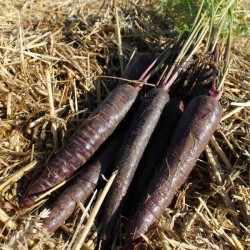



Purple Sun is a unique purple hybrid carrot, and the colour does not fade during cooking so will add a lot of fun to your dishes. These carrot seeds are Nantes type carrot. And the wonderful colour can encorage children too to eat more veggies. The darkest of dark purple colour, beautiful cylindrical roots.
If you’ve ever seen Queen Anne’s lace growing on the side of the road, you’ve seen the ancestor of the modern carrot. Carrots are very satisfying to pull out of the ground and, after some fiddly work at the beginning, are pretty easy to grow as well. However, there are a number of things a gardener needs to know in order to enjoy a bountiful harvest.
Light requirements: Carrots prefer full sun, but can be grown in partial shade.
Soil: Carrots like fluffy well-drained soil, the kind of “deep, loose, and sandy loam” that all the gardening books and catalogs talk about. This makes sense when you stop to consider the fact that carrots are a root vegetable, and those roots need to grow fairly straight. Soil that you can stick your pinkie finger in easily will work very well for carrots. However, you need to make sure the soil has more phosphorus and potassium than it does nitrogen. The ideal soil pH for carrots is somewhere around 6.5.
Seeds: Carrot seeds are tiny, which is why sowing them at the recommended spacing of 1 inch apart is a bit of a challenge. There are several ways around this problem. You can mix the carrot seeds with sand, well-sifted compost, or even coffee grounds, in order to help even the distribution. Some people mix in a few radish seeds with their carrot seeds, so that the faster-growing radish seedlings will mark the rows, break up any crusts in the soil, and the gardener will get two successive crops in one space.
Planting: However you decide to grow your carrots, plant your carrot seeds in your nice, fluffy soil, seeds, especially small ones, like a well aired soil, you’ll need to make sure that you plant them shallowly, with a very light covering. Sand, vermiculite, or well-sifted compost is your best bet here, because you don’t want the emerging seedlings to have to struggle through compacted soil, and you want the taproot – what you will eventually eat – to burrow downwards unimpeded. Water carefully, with a fine spray; you want the bed to be moist, but you don’t want the seeds to wash away, and you certainly don’t want the soil to get muddy and compacted. Carrots need consistent moisture. If you have planted them in raised beds, which many gardeners find is the easiest way to maintain the kind of soil they prefer, you will need to be especially vigilant about watering, since raised beds heat up and dry out more quickly than plots that are in the ground.
Carrots do not like very hot weather. Warm climate gardeners should plant carrots in the fall, winter, and spring. Cooler climate gardeners can plant carrots in the early spring, and then plant more every few weeks until around early August.
Thinning: Depending on the variety, as well as local conditions, carrot seeds take anywhere from 6 to 21 days to germinate. Once they emerge, keep an eye on them until they are 1 to 2 inches high. At that point, you will need to thin out any seedlings that are closer than 1 inch apart. The best way to do this first thinning is to use some little scissors to just snip them off. Later on, if the seedlings look crowded, thin them again by pulling some of the baby carrots to add to your salad. The idea is to give each carrot enough space to grow to full maturity.
Growing: After all this fiddly work getting them off to a good start, carrots can take care of themselves quite well. All you need to do is keep the weeds down, and maybe top dress with the fertilizer of your choice if they’re looking like they might need some extra nutrition. If you’ve been planting carrots in succession, add a layer of straw to the final group of seedlings, which will keep the carrots cooler in the heat, and protect them from the cold. One of the nifty things about carrots is that you can keep them in the ground to overwinter until January or February, depending on your gardening zone. Just remember to harvest them before they begin to look like Queen Anne’s lace.
Harvest: Harvest your carrots by grasping their “shoulders” wiggling a bit, and then twisting has you pull them up out of the ground. Do not try to pull them up by their stems, because those will just break. If your carrots don’t want to come up easily, loosening the soil parallel to the row with a digging fork should do the trick. Once the carrots are out of the ground cut the stems off right away, because they’ll just keep right on growing, even in the refrigerator, and suck the flavor and nutrients right out of the carrots you’ve worked so hard to grow.